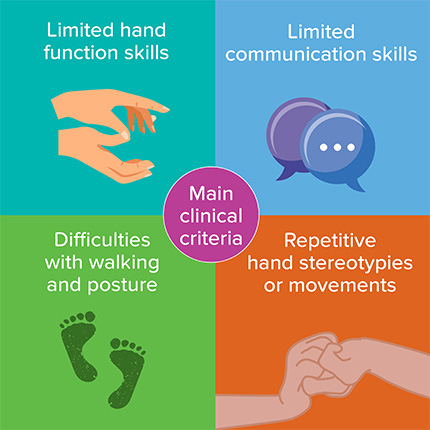What is Rett syndrome?
Rett syndrome is one of the 8,000 rare genetic diseases that collectively affect up to 10% of the population. It is typical of many other rare diseases in that it begins in childhood and is difficult to diagnose.
Rett syndrome is a rare genetic condition that is caused by a variant or mutation in the MECP2 gene. It mostly affects females but sometimes affects males.
The child’s early development appears normal, but there is then a period of developmental regression that occurs on average when the child is 18 months of age. Then, the child typically loses hand and communication skills and may find it more difficult to keep balance.
At around 8 months she totally changed from being quiet and placid to being unhappy and irritable. I thought it must have been her teeth. She was not bearing her own weight. Not waving, not interested in playing, would not clap or do simple things like all her friends.
There are 4 main criteria considered when diagnosing Rett syndrome
Following developmental regression, the main signs of Rett syndrome include:
-
Difficulties using the hands for grasping and holding objects.
-
Difficulties learning words.
-
Difficulty with walking.
-
Onset of hand stereotypies which are repetitive movements that are mostly seen in the hands. Examples include repetitive mouthing or washing movements of the hands.

Rett syndrome fundamentally affects how the individual moves. Muscle tone can be high or low. Many children have dyspraxia where planning and initiating movements are difficult and take a long time. Poor balance can be associated with difficulties standing and walking. Approximately one third of individuals learn to walk and keep the ability to walk as they grow older. Approximately 15-20% of individuals will be able to walk with assistance and continue to do this as they grow older. Approximately half are unable to walk but may be able to stand with assistance.
Whilst speech abilities are limited, individuals with Rett syndrome usually keep many communication skills, helped by their “intense eye communication”.
I think that seeing her happy and healthy and active and for me having learned about communicating when there’s no communication. So a child that isn’t able to talk or express what they want, she is a child that certainly knows how to get what she wants. And being able to pick up on those cues and understand and realise how much there is to communication and how much she can communicate without the verbal word.
The clinical spectrum of Rett syndrome is wide. Some individuals are more mildly affected and may only experience some of the 4 main criteria. They can still be diagnosed with Rett syndrome in the presence of supportive criteria.
Clinical variability is partly explained by the type of MECP2 mutation. Some MECP2 mutation types are usually associated with greater clinical severity. Individuals with these mutations tend to be less likely to learn to walk before regression, may experience developmental regression at an earlier age, and have poorer functional abilities. Other mutation types are associated with milder clinical severity. Individuals with these mutations tend to be more likely to learn to walk before regression, experience developmental regression at a later age, and have better functional abilities.
Main health issues
A child with RTT may experience several health issues at the same time. These are called comorbidities, and may include:
Epilepsy
Nearly two thirds will develop epilepsy with about half diagnosed by age five years. Seizures frequency varies for the type of MECP2 mutation.
Scoliosis
About three quarters will develop scoliosis and the average age of onset is approximately 11 years. Scoliosis is a sideways curvature of the spine which may cause difficulty with motor skills and movement.
Feeding difficulties
This is partly due to difficulties with chewing and swallowing. About a quarter of individuals will need feeding via a gastrostomy tube, for ease of providing feed, fluids, and medications.
Sleep difficulties/sleep problems
More than three quarters of individuals have problems with sleep. Sleep difficulties may include problems initiating sleep, night awakenings and irregular sleep/wake patterns.
Osteoporosis
About half of individuals are affected by osteoporosis. This is where the bones are weaker and less dense and can be associated with an increased risk of fracture. Physical activity can help build bone density.
Breathing irregularities/breathing abnormalities
Abnormal breathing is present in about three quarters of individuals ,and this includes episodes of hyperventilation, breath holding, and air swallowing. Air swallowing can be associated with uncomfortable abdominal bloating.